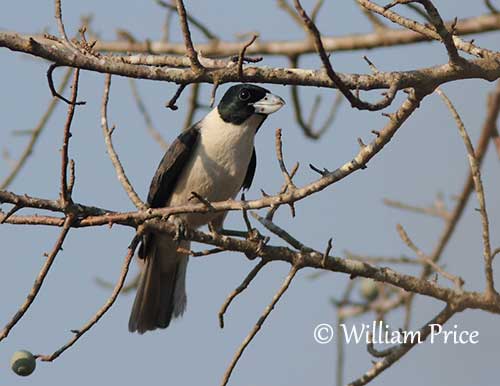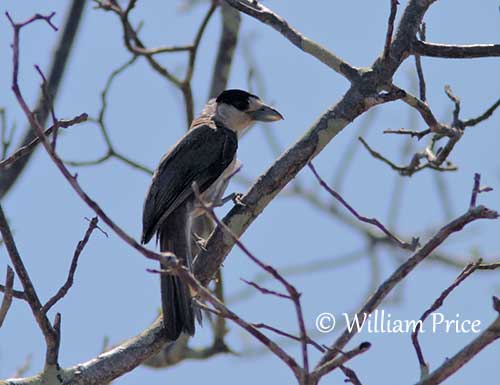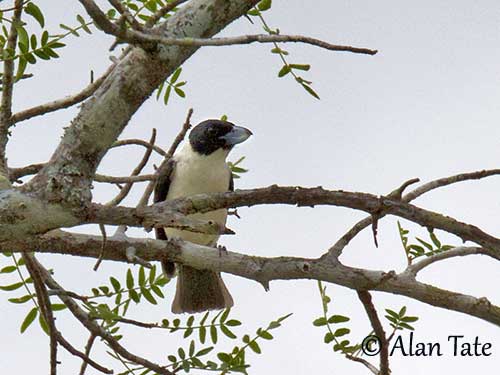
Fr: Vanga de Lafresnaye
Ang: Lafresnaye's Vanga
All: Schmalschnabelvanga
Esp: Vanga de Lafresnaye
Ita: Vanga di Lafresnaye
Nd: Lafresnayes Vanga
Sd: svarthakad vanga
Mal: Tsilovanga
Photographers:
John Anderson
John Anderson Photo Galleries
William Price
PBase-tereksandpiper & Flickr William Price
Alan & Ann Tate
AA Bird Photography
Text by Nicole Bouglouan
Sources:
HANDBOOK OF THE BIRDS OF THE WORLD Vol 14 by Josep del Hoyo-Andrew Elliot-David Christie - Lynx Edicions – ISBN: 9788496553507
Birds of the Indian Ocean Islands Par Ian Sinclair, Olivier Langrand - ISBN: 1868729567, 9781868729562- Editeur: Struik, 2003
Birds of Madagascar: A Photographic Guide Par Pete Morris, Frank Hawkins – ISBN: 0300077556, 9780300077551- Editeur: Yale University Press, 1998
The Birds of Africa: Volume VIII: The Malagasy Region: Madagascar, Seychelles, Comoros, Mascarenes - Par Roger Safford, Frank Hawkins – ISBN: 1408190494, 9781408190494- Editeur: A&C Black, 2013
Wikipedia, the free encyclopaedia
Creagus – Bird Families of the World – Vangas - Vanginae
THE VANGAS OF MADAGASCAR by Nick Garbutt
Lafresnaye’s Vanga
Xenopirostris xenopirostris
Passeriformes Order – Vangidae Family
INTRODUCTION:
The Lafresnaye’s Vanga is endemic to Madagascar where it occurs in sub-arid thorn scrub in S and SW of the island, in the Madagascar spiny forest ecoregion.
This medium-sized vanga has distinctive, thick, laterally compressed bill, well-adapted to its feeding behaviour in dead wood areas.
The Lafresnaye’s Vanga has restricted range in which it is not common, but the species is not globally threatened.
The name of this species pays tribute to Frédéric de Lafresnaye, a French ornithologist who described it.
DESCRIPTION OF THE BIRD:
Biometrics:
Length: 24 cm
Weight: 52-63 g
The Lafresnaye’s Vanga adult male has glossy black crown, lores, ear-coverts and chin, contrasting with the white throat and the broad, white collar broken on the nape.
The upperparts, including upperwing-coverts and tail, are mid-grey with brown wash. The plumage may appear darker in some lights. On the upperwing, primaries, primary-coverts and alula are sooty grey.
The underparts are white.
The bill is grey to bluish-white. The upper mandible shows dusky tip that may extend along culmen, whereas the lower mandible has pale tip. The thick bill is laterally compressed. The eyes are dark brown. Legs and feet are blue-grey.

The adult female resembles male, but she has white lores, forecrown and cheeks, and the upperparts are dull mid-grey-brown.
The juvenile is similar to female, but it has browner upperparts.
RANGE:
The Lafresnaye’s Vanga is found in SW and S Madagascar, between N of Mangoky River and E of Fort Dauphin.
HABITAT:
The Lafresnaye’s Vanga frequents the primary spiny forest and the coastal scrub with Euphorbia. It favours degraded areas with plentiful of dead wood for foraging. It occurs from sea-level to 100 metres of elevation.
CALLS AND SONGS: SOUNDS BY XENO-CANTO
The Lafresnaye’s Vanga gives frequently loud, highly-characteristic whistles “tseeeo”. It also gives a loud “whip” from perch, often at top of Didierea madagascariensis stem. We can also hear a slow “chuck-chuck-chuck” rather like Chabert’s Vanga voice. It also utters various descending whistles.

BEHAVIOUR IN THE WILD:
The Lafresnaye’s Vanga uses its thick, laterally compressed bill as a tool for ripping bark from dead wood. It probes like a woodpecker, searching carefully in crevices and bark in dead or broken wood.
It feeds on various invertebrates such as Coleopterans, Blattodea and others, and worms. It also catches small chameleons.
It forages at middle and lower levels, and often close to the forest floor.
The Lafresnaye’s Vanga is generally seen alone or in pairs. It may occasionally forage in groups of 6-8 individuals, and often joins mixed-species groups of other large vanga species.
The breeding behaviour is poorly known. The vangas of the genus Xenopirostris build basket-shaped nests with woven plant fibres. They are basically monogamous and territorial.
The Lafresnaye’s Vanga is sedentary in its restricted range.

REPRODUCTION OF THIS SPECIES:
The breeding season takes place in November/December.
The Lafresnaye’s Vanga builds a cup-shaped structure made with woven plants and fibres. The outer part is reinforced with spider webs, whereas the inner part is lined with pieces of leaf and rootlets. The nest is placed in tree fork, about 5 metres above the ground.
The female lays 2 reddish-white eggs with reddish-grey spots. Male and female share the incubation.
PROTECTION / THREATS / STATUS:
The Lafresnaye’s Vanga has restricted range on Madagascar. It is usually not common, although being fairly common at Ifaty.
The size of the population is unknown but the species is not globally threatened.
The Lafresnaye’s Vanga is currently evaluated as Least Concern.